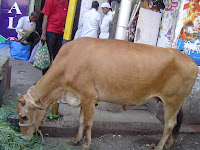 I always have fun explaining the 'sacred cow' thing to overseas visitors.
I always have fun explaining the 'sacred cow' thing to overseas visitors.As part of the Bhuleshwar bazaar walk, we take several overseas visitors to the temple of Mumbadevi, Bombay's patron goddess. The temple has two cows, in a makeshift cowshed. For two rupees, you can buy grass to feed the cows.
The last time I was there, one cow peed. A man came rushing out from the interior somewhere, with an empty plastic bottle, and he collected the urine. My guests were pretty flabbergasted.
They'd heard of the sacred cow, but, er, did that extend to urine? "What's he going to do with it, Deepa?", one of them asked.
I launched into my usual explanation of pancha-gavya, the five sacred products of the cow, and all the beliefs around the cow. My audience's eyes grew rounder and rounder as I went on.
"You mean they *eat* this panchathing?"
"It's used in Ayurveda as medicine" I said. "And it's also used as a natural fertiliser."
One of them turned around and asked me rather hesitantly, "Umm, do they run out and collect cow dung like that as well?"
I couldn't help laughing. I could see what he was imagining - a man waiting with cupped hands, perhaps, as the cow did its excretory thing. I had to explain that while cow urine had to be collected in transit, cow dung was definitely collected post landing. I tell you, tourism is great fun sometimes!
 But honestly, if you look at it a little seriously, cows are an administrator's nightmare.
But honestly, if you look at it a little seriously, cows are an administrator's nightmare.According to Ian Copland, a researcher with Monash University, and author of 'What to do about cows?', there were fifteen serious cow-related communal riots in British administered North India between 1883 and 1891. In 1893 a series of cow riots hit the cities of Bombay and Rangoon, the districts of Azamgarh, Ballia and Ghazipur in the United Provinces, and the princely state of Junagadh. In 1909 the killing of a cow triggered a major riot outside of Calcutta. Further cow riots followed in succeeding years - the most serious of which was a riot in 1917 in the Shahabad district of Bihar, where 150 villages were looted and burned.
Post-independence India has also seen a series of cow-related riots - in 1949 there were riots in Secunderabad over a tonga suspected of carrying beef in a Hindu area. As recently as 2003, there were riots in Ganj Basoda, a tiny town in Madhya Pradesh, over the alleged slaughter of a cow by a rickshaw-puller.
All this mess over an animal?

Ah, but this is not just another animal! This is Kamadhenu, cow-mother, divine benefactress, provider of milk and sustenance, she-whose-udders-never-run-dry, she-whose-urine-is-pure. And she has the Gods on her side.
"O noble folk, protect the cow, for Brahma is in her back, Vishnu in her throat, Shiva is established on her face...the Sun and Moon are in her eyes..." says a poster published by the Nagpur Cow Protection league in 1860. It's an amusing poster, if you're not religiously inclined.
Take a look. There's a seriously demonic looking guy with armpit hair and the face of a wolf, waving a sword over a cow. In front of him is this totally pious looking Hindu trying to stop the killing.
And if you still don't get the message, there's a milkman at the bottom of the poster, selling milk to a bunch of people, all from communities that have no taboos against beef - you can see a Parsi in characteristic black topi, an Englishman in a top hat and a Mussalman squatting in traditional robes. This is go-mata, cow-mother, the poster says to the beef-eater. She feeds everyone, including you.
It was rather interesting for me to read that post. Thank you for it. I like such topics and everything connected to this matter. I definitely want to read a bit more soon.
ReplyDeletePretty nice blog you've got here. Thanks for it. I like such topics and everything that is connected to this matter. I would like to read more soon.
ReplyDeleteKate Benedict